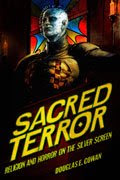 In the past I’ve mentioned an interesting website that I stumbled upon, Constructing Horror, a website that serves as a resource for horror writers.
In the past I’ve mentioned an interesting website that I stumbled upon, Constructing Horror, a website that serves as a resource for horror writers.
One of the perspectives that they address is the connection between religion and horror, an area of research interest for me, and their current e-newsletter touched on this topic with the title “Why Religion is Deeply Connected to Horror.” Although their recent email was brief, it confirmed that I am not the only one who sees such connections in contemporary horror (as well as sci fi and fantasy), and it also raised some interesting issues for me.
As to my seeing a connection between religion and speculative fiction in film, I try not to inappropriately read things into film, but instead attempt to allow the storytellers to convey the aspects of their stories that they want for viewers. My reservations about reading something into films that is not there made me hesitant to see much by way of the significance of the symbolism in the Spielberg remake of War of the Worlds, but as the reader will see below where I have copied the bulk of the Constructing Horror email, those at Constructing Horror saw something significant in one of the film’s scenes as well:
“Hell is overflowing, and Satan is sending his dead to us. Why?
Because, you have sex out of wedlock,
you kill unborn children, you have man on man relations,
same sex marriage. How do you think your
God will judge you? Well friends, now we know.
When there is no more room in hell, the dead will
walk the earth.”
– Televangelist, Dawn of the Dead
“Horror writer, director and producer Clive Barker once said that there are at least two books in every American household: ‘One of them is the Bible and the other one is probably by Stephen King.’ The connection between horror and the supernatural forces are everywhere. Not only in movies like The Exorcist, The Omen, and more recently films like The Reaping. It goes far beyond that and is a powerful tool in creating uncertainty, the doubt of hope and horror.
“Stories are filled with supernatural creatures. The first descriptions of a Land of the Dead where written by Sumerians some four thousand years ago on tablets made of clay from the Tigris – Euphrates Valley north of the Persian Gulf. One of the first stories ever written, The Epic of Gilgamesh, is about the mythical king Gilgamesh’s journey into the regions of the underworld in his quest for immortality.
“It is easy to think that the power of religion has faded away in a modern, secular society – but in the 1950’s a survey revealed that 50% of Americans still believed in “Hell.” In a second survey, 66% of the American population expressed that they believe in the “Devil” (1988).
“While movies like Hellraiser, Event Horizon, and Angel Heart successfully use traditional religious imagery – repetition make clichés.
“How can you use the powers of heaven and hell in your stories?
“Think about it. What building was the first to collapse in the remake of War of the Worlds? What was on the radio during the first few minutes of Jeepers Creepers? Who was the first infected person that the protagonist of 28 Days Later saw in the otherwise deserted London?
“These choices were all conscious decisions made by the horror storytellers. The church is the first building to be demolished by the aliens in War of the Worlds. The God referred to by the crazy evangelist on the radio in Jeepers Creepers will not be of any help to Trish and Darry, and you will definitely not be receiving a good blessing from the contaminated priest in 28 Days Later.
This technique is used everywhere. The unfortunate victims in the remake of The Hills Have Eyes soon realize that their prayers have no effect. Nobody, not even God, is coming to help anyone. Learn to use religious imagery in both obvious and subtle ways and you will have a powerful tool at your disposal.”
For those interested in an exploration of the complicated and often ambiguous relationship between horror and religion I highly recommend Douglas Cowan’s forthcoming book, Sacred Terror: Religion and Horror on the Silver Screen (Baylor University Press, October 2008).






Hi John!
I hadn’t checked your blog for a while — am glad to be back.
This is a very good, and important, article. I want to mention that the same connection exists in both the Anime and Manga produced in Japan. It is astounding that animistic Japanese are producing material that is often dripping with spiritual imagery — including a lot that comes from the Bible.
So, were you at Cornerstone again this year?
Hey, Paul. Good to hear from you. I’m glad you enjoyed the article, and noted the same type of connection in manga and anime.
I did not go to Cornerstone this year. It was time for a rotation off. But I hope to return next year, and at least to have some kind of creative input in their thinking for the fest regardless.
Still hoping that one day I can get to Japan for a visit.
this article was really interesting, and any more you have on religion in horror would be really useful, particularly on the omen, the exorcist and Carrie 🙂 its for a research project and i’d really appreciate your help
x